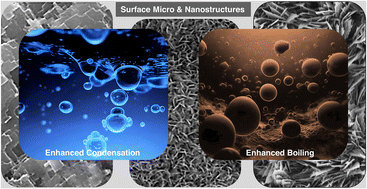Liquid–vapor phase change phenomena such as boiling and condensation are processes widely implemented in industrial systems such as power plants, refrigeration and air conditioning systems, desalination plants, water processing installations and thermal management devices due to their enhanced heat transfer capability when compared to single-phase processes. The last decade has seen significant advances in the development and application of micro and nanostructured surfaces to enhance phase change heat transfer. Phase change heat transfer enhancement mechanisms on micro and nanostructures are significantly different from those on conventional surfaces. In this review, we provide a comprehensive summary of the effects of micro and nanostructure morphology and surface chemistry on phase change phenomena. Our review elucidates how various rational designs of micro and nanostructures can be utilized to increase heat flux and heat transfer coefficient in the case of both boiling and condensation at different environmental conditions by manipulating surface wetting and nucleation rate. We also discuss phase change heat transfer performance of liquids having higher surface tension such as water and lower surface tension liquids such as dielectric fluids, hydrocarbons and refrigerants. We discuss the effects of micro/nanostructures on boiling and condensation in both external quiescent and internal flow conditions. The review also outlines limitations of micro/nanostructures and discusses the rational development of structures to mitigate these limitations. We end the review by summarizing recent machine learning approaches for predicting heat transfer performance of micro and nanostructured surfaces in boiling and condensation applications.
